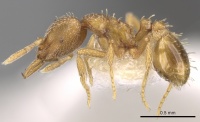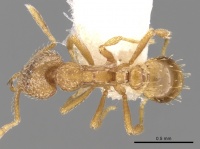Strumigenys traegaordhi
| Strumigenys traegaordhi | |
|---|---|

| |
| Scientific classification | |
| Kingdom: | Animalia |
| Phylum: | Arthropoda |
| Class: | Insecta |
| Order: | Hymenoptera |
| Family: | Formicidae |
| Subfamily: | Myrmicinae |
| Tribe: | Attini |
| Genus: | Strumigenys |
| Species: | S. traegaordhi |
| Binomial name | |
| Strumigenys traegaordhi Santschi, 1913 | |
Known from litter-samples taken in montane rainforest and evergreen forest.
Identification
A member of the arnoldi complex in the Strumigenys arnoldi-group.
Bolton (1983) - The closest relative of traegaordhi is Strumigenys mesahyla, known from Zimbabwe. The two are superficially very similar but differ as follows.
| traegaordhi | mesahyla |
| Dorsum of head with 6 standing hairs, the hairs slender. | Dorsum of head with 4 standing hairs, the hairs thick. |
| Hairs of cephalic ground-pilosity the same everywhere on the head. | Hairs of cephalic ground-pilosity much narrower posteriorly than anteriorly. |
| Mesonotum with 2 pairs of stout standing hairs. | Mesonotum with a single pair of stout standing hairs. |
| Reticulate-punctate sculpture predominant on pronotum. | Longitudinal rugular sculpture predominant on pronotum. |
| Ventral spongiform lobe slightly smaller than exposed area of disc in profile. | Ventral spongiform lobe much larger than exposed area of disc in profile. |
| Basigastral costulae arising across entire width of first tergite. | Basigastral costulae arising on each side of a clear central area on first tergite. |
Keys including this Species
Distribution
Latitudinal Distribution Pattern
Latitudinal Range: -33.91667° to -34.06667°.
| North Temperate |
North Subtropical |
Tropical | South Subtropical |
South Temperate |
- Source: AntMaps
Distribution based on Regional Taxon Lists
Afrotropical Region: Eritrea, South Africa (type locality).
Distribution based on AntMaps
Distribution based on AntWeb specimens
Check data from AntWeb
Countries Occupied
| Number of countries occupied by this species based on AntWiki Regional Taxon Lists. In general, fewer countries occupied indicates a narrower range, while more countries indicates a more widespread species. |

|
Estimated Abundance
| Relative abundance based on number of AntMaps records per species (this species within the purple bar). Fewer records (to the left) indicates a less abundant/encountered species while more records (to the right) indicates more abundant/encountered species. |

|
Biology
Castes
Images from AntWeb

| |
| Worker. Specimen code casent0280729. Photographer Shannon Hartman, uploaded by California Academy of Sciences. | Owned by NHMUK, London, UK. |
Nomenclature
The following information is derived from Barry Bolton's Online Catalogue of the Ants of the World.
- traegaordhi. Strumigenys (Strumigenys) traegaordhi Santschi, 1913b: 257 (diagnosis in key) (w.) SOUTH AFRICA. Santschi, 1914e: 28 (w.); Emery, 1915g: 19 (q.). See also: Brown, 1954k: 27; Bolton, 1983: 396; Bolton, 2000: 598.
Unless otherwise noted the text for the remainder of this section is reported from the publication that includes the original description.
Description
Worker
Bolton (1983) - TL 2.0-2.1, HL 0.54-0.55, HW 0.43, CI 78-80, ML 0.24, MI 44, SL 0.30, SI 70, PW 0.28, AL 0.59-0.60 (2 measured).
Apical fork of each mandible with 2 teeth, without intercalary teeth or denticles. Preapical armament of each blade of 2 teeth, the proximal distinctly longer than the distal and both teeth situated in the apical third of the length of the blade. Upper scrobe margins bordered by a narrow rim, the eyes not visible in full-face view. Eyes small, their maximum diameter distinctly less than the maximum width of the scape. Preocular notch absent, the ventral surface of the head without a preocular transverse groove or impression on each side. Antennal scapes shallowly curved in the basal third and slightly expanded in the median third, broadest at about the midlength. Leading edges of scapes shallowly convex and with a row of apically curved narrowly spoon-shaped hairs. Dorsum of head with ground-pilosity which becomes narrower and finer from front to back. Anteriorly, from the level of the posterior clypeal margin to about the level of the ends of the preocular laminae the hairs are spoon-shaped and quite broad, appearing almost scale-like in full-face view. Behind this level, and posteriorly over the highest point of the vertex to the occipital margin, the hairs are much narrower and less conspicuous, narrowly spatulate in shape. Hairs fringing the upper scrobe margins spoon-shaped and as large as those on the anterior portion of the cephalic dorsum. In profile the dorsum of the head with 6 standing hairs arranged in a row of 4 close to the occipital margin and a more anteriorly situated pair which are about at the highest point of the vertex. Dorsum of head reticulate-punctate. Pronotal humeri each with an elongate fine flagellate hair, the mesonotum with two pairs of standing hairs, the posterior pair of which is only half as long as the anterior pair. Ground-pilosity of dorsal alitrunk of sparse narrowly spatulate hairs similar to those on the head behind the highest point of the vertex. Metanotal groove present as a feeble line across the dorsum. Apical portions of propodeal teeth, which are free from the narrow infradental lamellae, very narrowly triangular and almost spiniform. Sides of alitrunk mostly smooth, the pleurae and sides of the propodeum with some peripheral punctures. Dorsal alitrunk reticulate-punctate, the pronotum also with some weak longitudinal rugulae. Dorsum of petiole node reticulate-punctate, the postpetiole smooth or at most with a few feeble punctures posteriorly. Spongiform appendages of pedicel segments moderately developed. In profile the petiole with a narrow ventral strip and a small lateral lobe, the postpetiole with the ventral lobe slightly smaller than the exposed area of the postpetiolar disc in profile. Basigastral costulae short but quite strongly defined. Petiole, postpetiole and gaster with standing stout hairs which are swollen or feebly clavate apically. Colour brown.
Bolton (2000) - TL 2.0-2.2, HL 0.54-0.57, HW 0.41-0.44, CI 76-80, ML 0.22-0.24, MI 40-44, SL 0.30-0.34, SI 70-77, PW 0.28-0.30, AL 0.59-0.63 (10 measured).
Type Material
Bolton (1983) - Syntype workers, SOUTH AFRICA: Natal, Piertermaritzburg (1. Triigardh) (Naturhistorisches Museum, Basel) [examined].
References
- Bolton, B. 1983. The Afrotropical dacetine ants (Formicidae). Bulletin of the British Museum (Natural History). Entomology. 46:267-416. (page 396, redescription of worker)
- Bolton, B. 2000. The ant tribe Dacetini. Memoirs of the American Entomological Institute. 65:1-1028. (page 598, redescription of worker)
- Brown, W. L., Jr. 1954k. The ant genus Strumigenys Fred. Smith in the Ethiopian and Malagasy regions. Bulletin of the Museum of Comparative Zoology 112: 1-34 (page 27, redescription of worker)
- Emery, C. 1915e. Formiche raccolte nell'Eritrea dal Prof. F. Silvestri. Boll. Lab. Zool. Gen. Agrar. R. Sc. Super. Agric. 10: 3-26 (page 19, queen described)
- Santschi, F. 1913b. Clé analytique des fourmis africaines du genre Strumigenys Sm. (Hym.). Bull. Soc. Entomol. Fr. 1913: 257-259 (page 257, worker described)
- Santschi, F. 1914e. Meddelanden från Göteborgs Musei Zoologiska Afdelning. 3. Fourmis du Natal et du Zoulouland récoltées par le Dr. I. Trägårdh. Göteb. K. Vetensk. Vitterh. Samh. Handl. 15: 1-44 (page 28, worker described)
References based on Global Ant Biodiversity Informatics
- Arnold G. 1917. A monograph of the Formicidae of South Africa. Part III. Myrmicinae. Annals of the South African Museum. 14: 271-402.
- Bolton, B. 2000. The Ant Tribe Dacetini. Memoirs of the American Entomological Institute 65
- Emery C. 1915. Formiche raccolte nell'Eritrea dal Prof. F. Silvestri. Bollettino del Laboratorio di Zoologia Generale e Agraria della Reale Scuola Superiore d'Agricoltura. Portici 10: 3-26.
- Finzi B. 1939. Materiali zoologici dell'Eritrea raccolti da G. Müller durante la spedizione dell'Istituto Sieroterapico Milanese e conservati al Museo di Trieste. Parte III. Hymenoptera: Formicidae. Atti del Museo Civico di Storia Naturale di Trieste 14: 153-168.
- Madl M. 2019. Notes on the ant fauna of Eritrea (Insecta: Hymenoptera: Formicidae): type specimens deposited in the Natural History Museum Vienna (Austria) and a preliminary checklist. Ann. Naturhist. Mus. Wien, B 121: 9-18.
- Santschi F. 1914. Meddelanden från Göteborgs Musei Zoologiska Afdelning. 3. Fourmis du Natal et du Zoulouland récoltées par le Dr. I. Trägårdh. Göteborgs Kungliga Vetenskaps och Vitterhets Samhälles Handlingar. 15: 1-44.
- Wheeler W. M. 1922. Ants of the American Museum Congo expedition. A contribution to the myrmecology of Africa. VIII. A synonymic list of the ants of the Ethiopian region. Bulletin of the American Museum of Natural History 45: 711-1004

